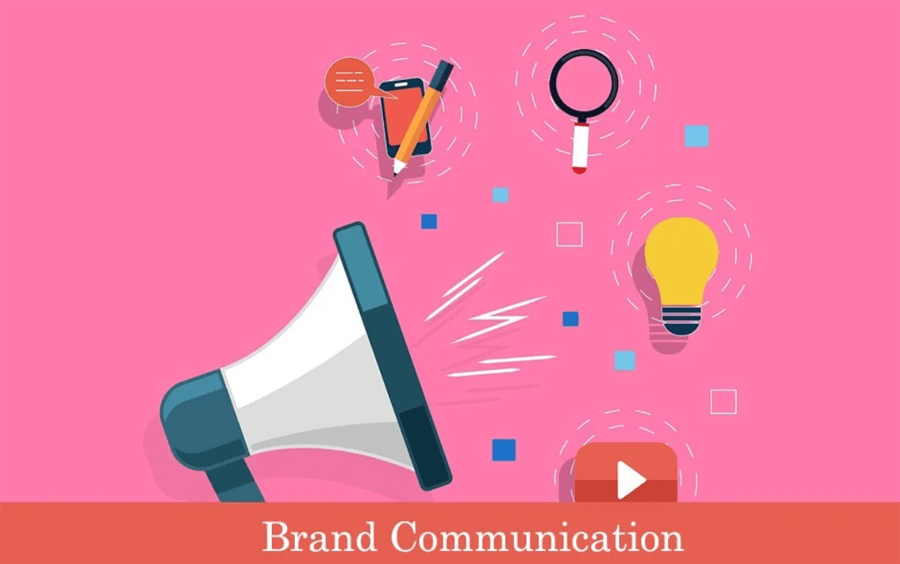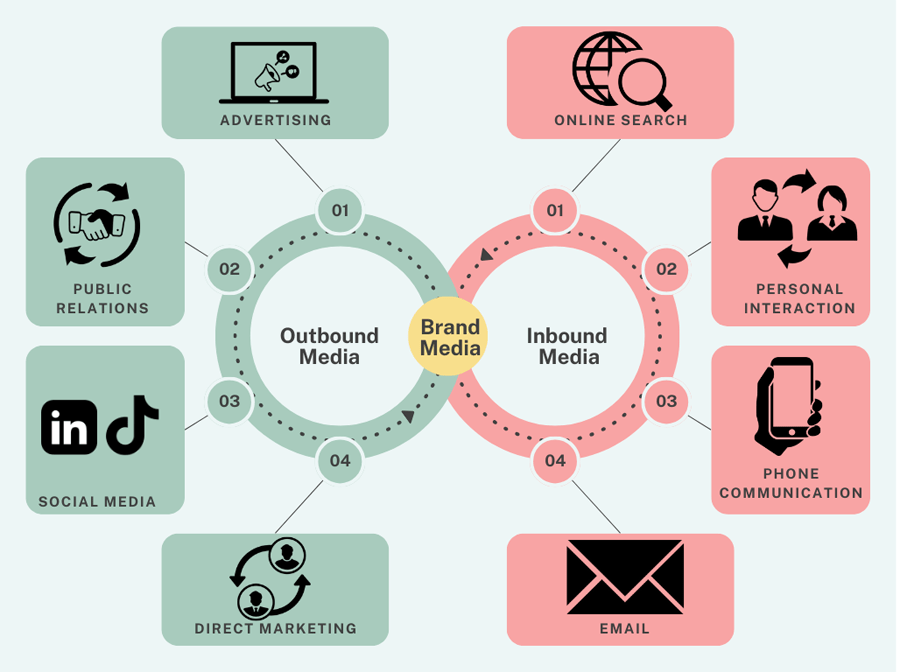Brand Communication

In today’s crowded marketplace, effective brand communication is the key to standing out and connecting with your target audience.
Brand communication involves sending a clear and interesting message to target audience about what they offer (company, product, or service). It is all about using text, voice and visuals to create a strong image in customer’s minds, highlighting the brand’s identity, values, and what it stands for.
Why it is Important
Good brand communication can help you achieve several things. These include:
- Creating brand awareness and recognition
- Creating a good brand image
- Differentiating yourself from the competition
- Creating customer loyalty
- Generating sales
Brand Communication for Brand Equity
The way you communicate your brand can make or break your success. Learn the proven techniques to enhance your brand equity via brand communication in this blog.
Tailor Your Communication to a Wider Market
Tailor your communications to a broader market while keeping your brand’s message strong by aligning all communications with your brand’s core values.
Use clear and concise messages that resonate with diverse audiences. Avoid technical jargon and language specific to certain segments.
Use Storytelling
Use storytelling techniques to create engaging and memorable content that emotionally resonates with your audience. Share compelling stories that reflect your brand values.
Build an emotional connection with customers by fostering a sense of community around your brand and using relatable, human-centered content.
Leverage User-Generated Content
Feature user stories, experiences, and successes to build a community around your brand. This adds authenticity and relatability to your voice.
Optimize Your Communications Channels
Communicate with your audience through various channels such as social media, email campaigns, and web content to ensure maximum impact for your strategy. Execute market studies to discover your target audience’s drives and needs to make accurate fine-tuning of your communication strategy
Establish a Unifying Messaging Strategy
Craft a transparent and consistent story that conveys your brand’s promises and value propositions. By doing so, audiences learn exactly what your brand represents and delivers.
Integrate Social Media in Your Strategy
Leverage social media to foster customer relationships, grow online presence, and interact with your audience through customer service and events.
Create Consistency in Communication
Have a consistent tone, voice, and personality in all communication channels and touchpoints. This builds recognition and trust among your audience.
Experiment and Learn
Do not hesitate to try new stuff, experiment with different approaches, and find fresh opportunities with your voice. Introduce personality, humor, and playfulness to make your brand stand out.
Regularly experiment with your brand voice on platforms via A/B testing and tracking. Monitor reactions from the audience to identify trends and tweak your voice based on data-driven assessments.
Brand Media

Media are the channels by which a company communicates the message of its brand to its customers. There are two types of media: inbound and outbound, depending on whether the initiative for the communication is taken by the company or the customer.
Outbound Media
Outbound media is company-initiated brand communication. Advertising, public relations, and social media are some of its most common types.
Advertising
Brand advertising establishes strong, long-term ties with customers, establishing brand believability and loyalty intellectually as well as emotionally. It utilizes a variety of media such as television, print (newspapers, magazines, journals), radio, internet, direct selling, billboards, mailings, contests, sponsorships, posters, events, and endorsements to communicate effectively.
Public Relations (PR)
PR, or public relations, involves spreading news about a person or business to the media and public. Its main goals include sharing company updates, defending brand reputation, and spinning negative news into positive news to build brand recognition. Its operations can include press releases, news conferences, interviews with journalists, and social media updates.
Unlike advertising, PR firms do not purchase ad space, write stories for news, or have expertise in paid ads. Rather, PR builds brands by advancing them via editorial coverage in magazines, newspapers, news shows, websites, blogs, or TV shows.
Social Media
Social media is websites and apps like Facebook, Instagram, X, and YouTube that are concerned with communication, community interaction, sharing, and collaboration. Categories of social media include forums, microblogging, social networking, social bookmarking, social curation, and wikis.
Social media is a key promotional tool for businesses. Social media enables businesses to communicate with customers, promote their products and services, monitor consumer behavior, and provide customer support.
Direct Marketing
Direct marketing focuses on particular people or businesses with the aim of boosting sales, brand visibility, or new business generation. It uses techniques such as telemarketing, email marketing, and direct mail.
Direct marketing differs from conventional PR campaigns handled by the media in that it is more intimate with its target group. They connect directly via social media, email, or postal mail for dissemination of messages and sales pitches to businesses. Becoming personal in their communications by including the recipient’s name and reference to their city, would pay big reward to brand.
Personal Selling
Personal selling is face-to-face customer contact by representatives to make direct impact on buying decisions.
It is interested in understanding and fulfilling the needs and desires of buyers without forcing them. A good salesperson provides guidance and information to help buyers save time and money. They should be willing to hear any objections buyers may have, demonstrating a genuine interest in meeting the buyer’s needs instead of making a sale.
Event Sponsorship
Event sponsorship is when organizations sponsor events with monetary donations, products, or services, and it is a highly lucrative form of sponsorship. It raises awareness by aligning the company image with high-profile events.
When the alignment is very strong between the event and sponsor, messages can freely spread without necessarily planning the event. This form of sponsorship enables organizations to host bigger and more impactful events at minimal cost to both the sponsor and event organizer. It is a win-win.
Inbound Media
It is public-initiated brand dialogue, not commerce. It involves online search, word-of-mouth, and cell phone discussions.
Online Search
Consumers deliberately search online data on brands in various forms, such as text, video, and audio. Google, YouTube, and Amazon are a few common online search portals. SEM and SEO are primary online search advertising vehicles.
SEO stands for the activity of optimizing a website to receive more traffic and assist brand-associated keywords in topping search engine result pages. An example is if a cereal company adds relevant words, makes content easier to read, and links to outside material to top organic results for terms like “cereal.”.
On the other hand, SEM targets driving traffic by means of cost-per-click ad channels like pay-per-click. For instance, a cereal brand can bid for terms like “cereal” so that it shows up first on paid searches whenever consumers query the term.
Personal Interaction
Inbound marketing involves personal interaction, where customers can ask questions about the company and directly communicate with agents. This kind of communication is essential in building customer loyalty, constructing strong relations, and maintaining customer satisfaction in the long term.
Phone communication
Customers can contact the company on the phone to obtain proper information and address specific problems. This communication is almost personal, but carried out away from faces.
Live chat
The company can communicate with website visitors through live chat to understand their goals and needs, and inform them about the company’s brand. The communication is as close to human communication but conducted online. Online forums allow customers to talk to the company directly on its website without having to go somewhere else.
Email is an alternative to inbound media. It comes in handy when customers need to communicate in a more reflective, systematic manner.
Conclusion
Brand communication plays a significant role in reaching out to customers, building trust, and maintaining loyalty. It ensures that a brand’s message becomes clear and involving for its target audience, increasing recognition and recall.
Effective brand communication creates brand identity and positive consumer perception, building brand equity. Outbound media like advertisement disseminates the brand message far and wide, while inbound media like social interaction builds customer relationships and word-of-mouth. Together, these efforts shape a brand’s image and positioning in the market, critical to sustained success in today’s competitive marketplace.